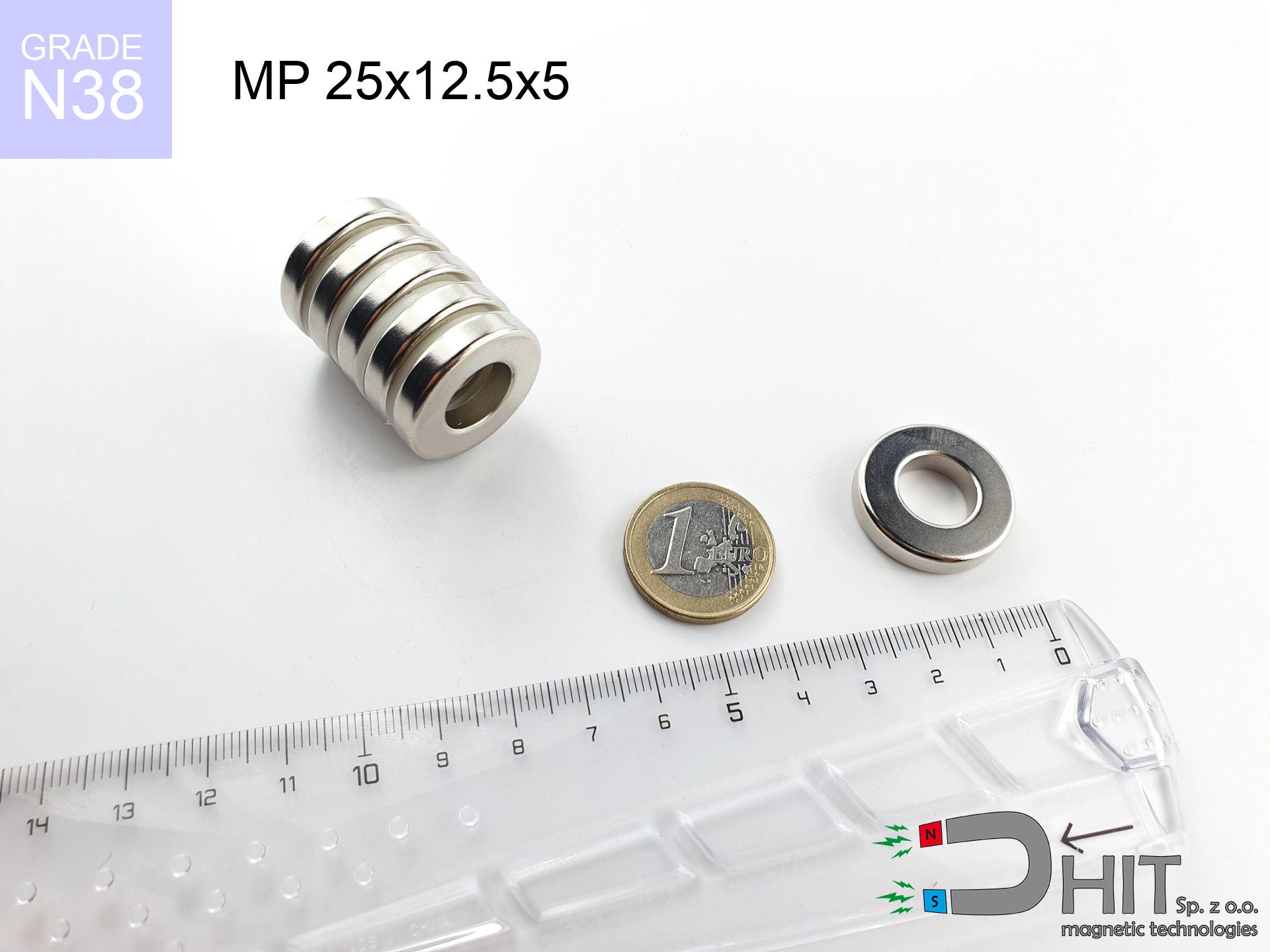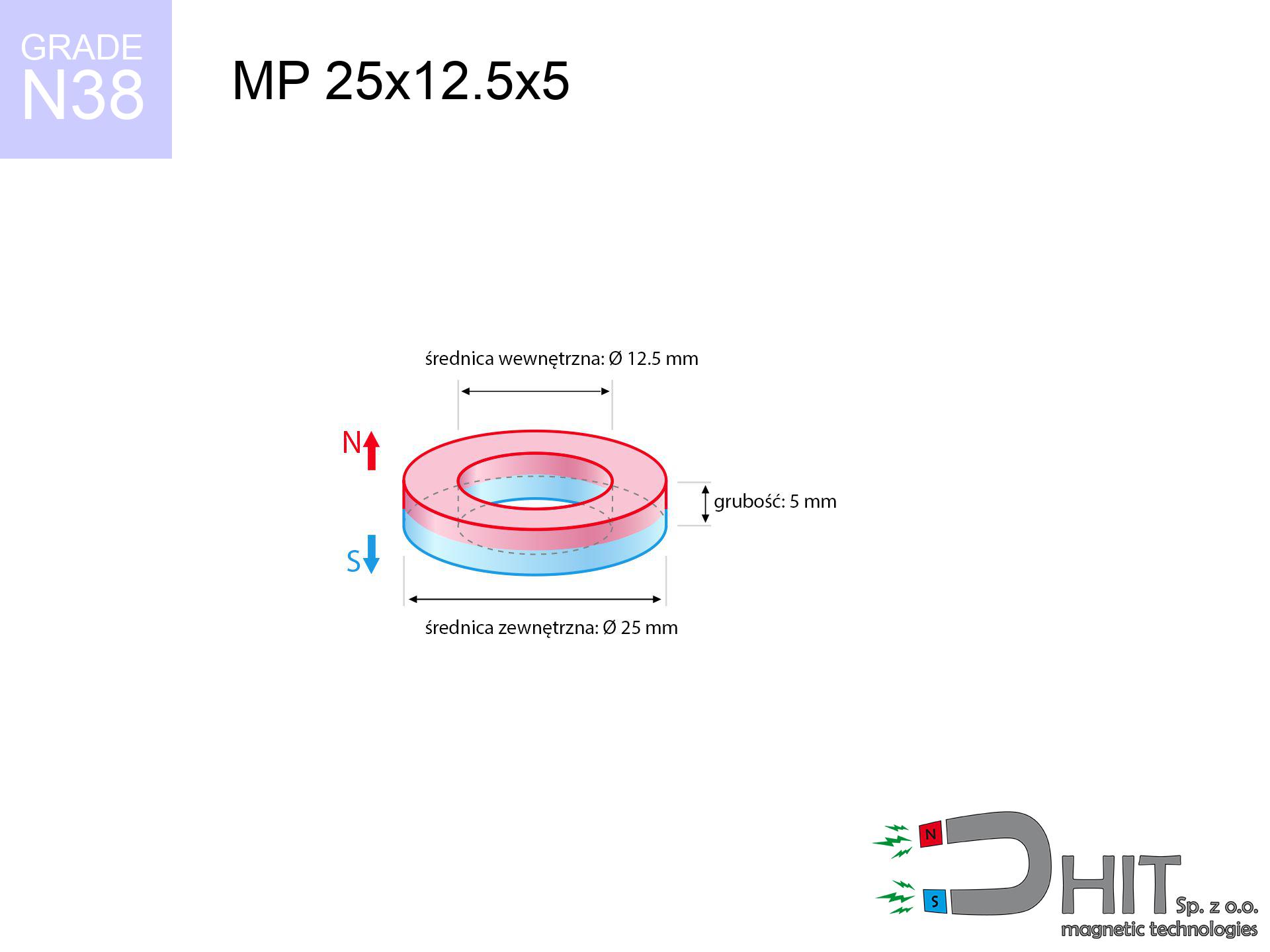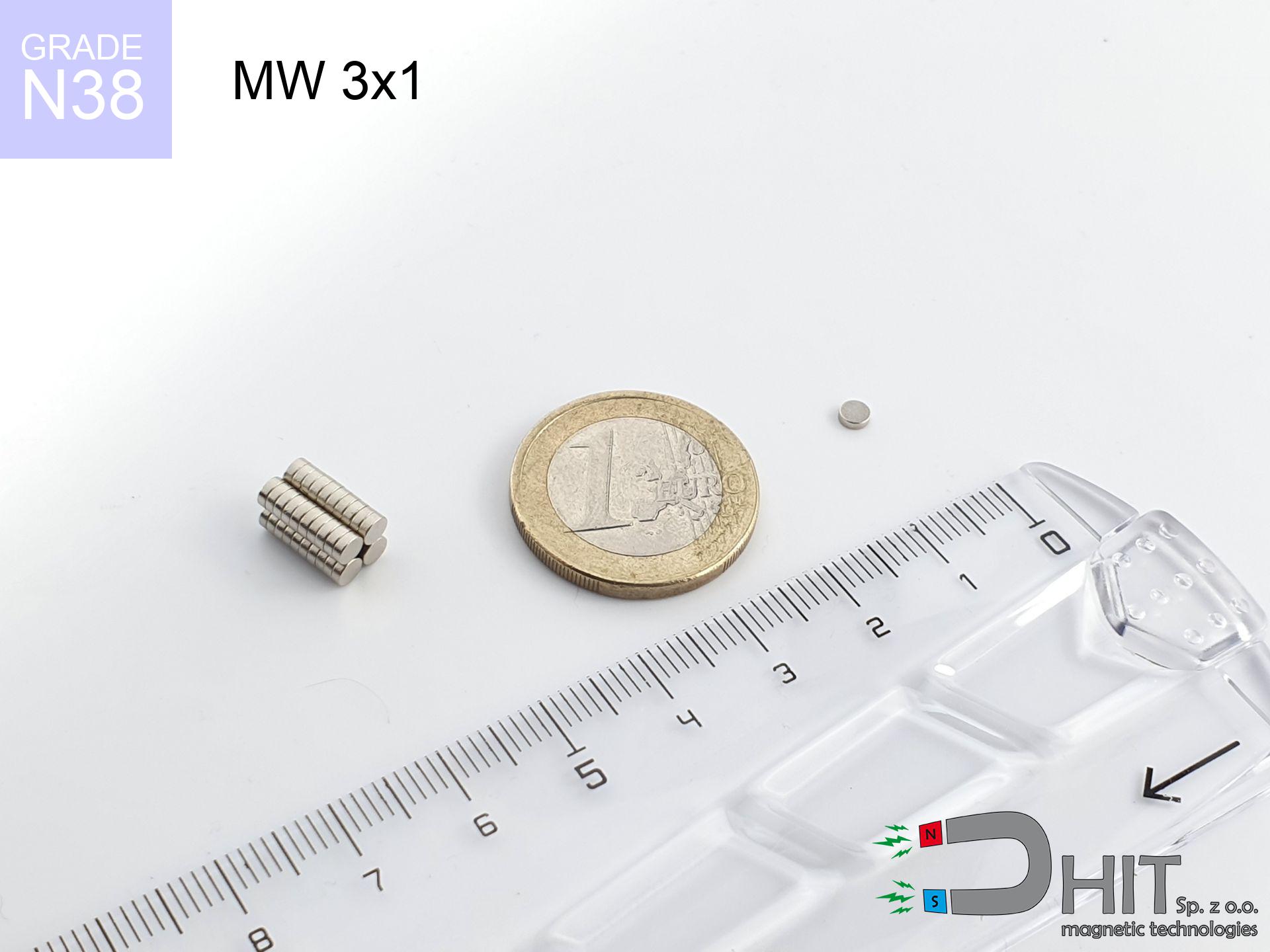MP 25x12.5x5 / N38 - ring magnet
ring magnet
Catalog no 030342
GTIN: 5906301812289
Diameter
25 mm [±0,1 mm]
internal diameter Ø
12.5 mm [±0,1 mm]
Height
5 mm [±0,1 mm]
Weight
13.81 g
Magnetization Direction
↑ axial
Load capacity
5.98 kg / 58.67 N
Magnetic Induction
0.23 mT / 2 Gs
Coating
[NiCuNi] Nickel
6.20 ZŁ with VAT / pcs + price for transport
5.04 ZŁ net + 23% VAT / pcs
bulk discounts:
Need more?Can't decide what to choose?
Call us
+48 888 99 98 98
otherwise contact us through
request form
through our site.
Weight along with form of magnets can be verified on our
modular calculator.
Order by 14:00 and we’ll ship today!
MP 25x12.5x5 / N38 - ring magnet
Specification / characteristics MP 25x12.5x5 / N38 - ring magnet
| properties | values |
|---|---|
| Cat. no. | 030342 |
| GTIN | 5906301812289 |
| Production/Distribution | Dhit sp. z o.o. |
| Country of origin | Poland / China / Germany |
| Customs code | 85059029 |
| Diameter | 25 mm [±0,1 mm] |
| internal diameter Ø | 12.5 mm [±0,1 mm] |
| Height | 5 mm [±0,1 mm] |
| Weight | 13.81 g |
| Magnetization Direction | ↑ axial |
| Load capacity ~ ? | 5.98 kg / 58.67 N |
| Magnetic Induction ~ ? | 0.23 mT / 2 Gs |
| Coating | [NiCuNi] Nickel |
| Manufacturing Tolerance | ±0.1 mm |
Magnetic properties of material N38
| properties | values | units |
|---|---|---|
| remenance Br [Min. - Max.] ? | 12.2-12.6 | kGs |
| remenance Br [Min. - Max.] ? | 1220-1260 | T |
| coercivity bHc ? | 10.8-11.5 | kOe |
| coercivity bHc ? | 860-915 | kA/m |
| actual internal force iHc | ≥ 12 | kOe |
| actual internal force iHc | ≥ 955 | kA/m |
| energy density [Min. - Max.] ? | 36-38 | BH max MGOe |
| energy density [Min. - Max.] ? | 287-303 | BH max KJ/m |
| max. temperature ? | ≤ 80 | °C |
Physical properties of sintered neodymium magnets Nd2Fe14B at 20°C
| properties | values | units |
|---|---|---|
| Vickers hardness | ≥550 | Hv |
| Density | ≥7.4 | g/cm3 |
| Curie Temperature TC | 312 - 380 | °C |
| Curie Temperature TF | 593 - 716 | °F |
| Specific resistance | 150 | μΩ⋅Cm |
| Bending strength | 250 | Mpa |
| Compressive strength | 1000~1100 | Mpa |
| Thermal expansion parallel (∥) to orientation (M) | (3-4) x 106 | °C-1 |
| Thermal expansion perpendicular (⊥) to orientation (M) | -(1-3) x 10-6 | °C-1 |
| Young's modulus | 1.7 x 104 | kg/mm² |
Engineering modeling of the product - technical parameters
These information represent the outcome of a mathematical analysis. Values were calculated on algorithms for the material NdFeB. Operational parameters may deviate from the simulation results. Treat these calculations as a preliminary roadmap during assembly planning.
MP 25x12.5x5 / N38
| Distance (mm) | Induction (Gauss) / mT | Pull Force (kg) | Risk Status |
|---|---|---|---|
| 0 mm |
5777 Gs
577.7 mT
|
5.98 kg / 5980.0 g
58.7 N
|
warning |
| 1 mm |
5310 Gs
531.0 mT
|
5.05 kg / 5051.8 g
49.6 N
|
warning |
| 2 mm |
4846 Gs
484.6 mT
|
4.21 kg / 4206.8 g
41.3 N
|
warning |
| 5 mm |
3576 Gs
357.6 mT
|
2.29 kg / 2291.1 g
22.5 N
|
warning |
| 10 mm |
2073 Gs
207.3 mT
|
0.77 kg / 769.7 g
7.6 N
|
safe |
| 15 mm |
1231 Gs
123.1 mT
|
0.27 kg / 271.6 g
2.7 N
|
safe |
| 20 mm |
773 Gs
77.3 mT
|
0.11 kg / 106.9 g
1.0 N
|
safe |
| 30 mm |
356 Gs
35.6 mT
|
0.02 kg / 22.7 g
0.2 N
|
safe |
| 50 mm |
115 Gs
11.5 mT
|
0.00 kg / 2.4 g
0.0 N
|
safe |
MP 25x12.5x5 / N38
| Surface type | Friction coefficient / % Mocy | Max load (kg) |
|---|---|---|
| Raw steel |
µ = 0.3
30% Nominalnej Siły
|
1.79 kg / 1794.0 g
17.6 N
|
| Painted steel (standard) |
µ = 0.2
20% Nominalnej Siły
|
1.20 kg / 1196.0 g
11.7 N
|
| Oily/slippery steel |
µ = 0.1
10% Nominalnej Siły
|
0.60 kg / 598.0 g
5.9 N
|
| Magnet with anti-slip rubber |
µ = 0.5
50% Nominalnej Siły
|
2.99 kg / 2990.0 g
29.3 N
|
MP 25x12.5x5 / N38
| Steel thickness (mm) | % power | Real pull force (kg) |
|---|---|---|
| 0.5 mm |
|
0.60 kg / 598.0 g
5.9 N
|
| 1 mm |
|
1.50 kg / 1495.0 g
14.7 N
|
| 2 mm |
|
2.99 kg / 2990.0 g
29.3 N
|
| 5 mm |
|
5.98 kg / 5980.0 g
58.7 N
|
| 10 mm |
|
5.98 kg / 5980.0 g
58.7 N
|
MP 25x12.5x5 / N38
| Ambient temp. (°C) | Power loss | Remaining pull | Status |
|---|---|---|---|
| 20 °C | 0.0% |
5.98 kg / 5980.0 g
58.7 N
|
OK |
| 40 °C | -2.2% |
5.85 kg / 5848.4 g
57.4 N
|
OK |
| 60 °C | -4.4% |
5.72 kg / 5716.9 g
56.1 N
|
OK |
| 80 °C | -6.6% |
5.59 kg / 5585.3 g
54.8 N
|
|
| 100 °C | -28.8% |
4.26 kg / 4257.8 g
41.8 N
|
MP 25x12.5x5 / N38
| Gap (mm) | Attraction (kg) (N-S) | Repulsion (kg) (N-N) |
|---|---|---|
| 0 mm |
8.97 kg / 8970.0 g
88.0 N
|
N/A |
| 2 mm |
6.31 kg / 6315.0 g
62.0 N
|
5.89 kg / 5894.0 g
57.8 N
|
| 5 mm |
3.44 kg / 3435.0 g
33.7 N
|
3.21 kg / 3206.0 g
31.5 N
|
| 10 mm |
1.16 kg / 1155.0 g
11.3 N
|
1.08 kg / 1078.0 g
10.6 N
|
| 20 mm |
0.17 kg / 165.0 g
1.6 N
|
0.15 kg / 154.0 g
1.5 N
|
| 50 mm |
0.00 kg / 0.0 g
0.0 N
|
0.00 kg / 0.0 g
0.0 N
|
MP 25x12.5x5 / N38
| Object / Device | Limit (Gauss) / mT | Safe distance |
|---|---|---|
| Pacemaker | 5 Gs (0.5 mT) | 17.0 cm |
| Hearing aid | 10 Gs (1.0 mT) | 13.5 cm |
| Timepiece | 20 Gs (2.0 mT) | 10.5 cm |
| Phone / Smartphone | 40 Gs (4.0 mT) | 8.0 cm |
| Car key | 50 Gs (5.0 mT) | 7.5 cm |
| Payment card | 400 Gs (40.0 mT) | 3.0 cm |
| HDD hard drive | 600 Gs (60.0 mT) | 2.5 cm |
MP 25x12.5x5 / N38
| Start from (mm) | Speed (km/h) | Energy (J) | Predicted outcome |
|---|---|---|---|
| 10 mm |
22.61 km/h
(6.28 m/s)
|
0.27 J | |
| 30 mm |
36.44 km/h
(10.12 m/s)
|
0.71 J | |
| 50 mm |
46.94 km/h
(13.04 m/s)
|
1.17 J | |
| 100 mm |
66.37 km/h
(18.43 m/s)
|
2.35 J |
MP 25x12.5x5 / N38
| Technical parameter | Value / Description |
|---|---|
| Coating type | [NiCuNi] Nickel |
| Layer structure | Nickel - Copper - Nickel |
| Layer thickness | 10-20 µm |
| Salt spray test (SST) ? | 24 h |
| Recommended environment | Indoors only (dry) |
MP 25x12.5x5 / N38
| Environment | Effective steel pull | Effect |
|---|---|---|
| Air (land) | 5.98 kg | Standard |
| Water (riverbed) |
6.85 kg
(+0.87 kg Buoyancy gain)
|
+14.5% |
Other offers
Pros as well as cons of neodymium magnets.
In addition to their long-term stability, neodymium magnets provide the following advantages:
- They have constant strength, and over nearly ten years their performance decreases symbolically – ~1% (in testing),
- They retain their magnetic properties even under close interference source,
- By applying a shiny coating of nickel, the element presents an proper look,
- The surface of neodymium magnets generates a unique magnetic field – this is a distinguishing feature,
- Due to their durability and thermal resistance, neodymium magnets can operate (depending on the form) even at high temperatures reaching 230°C or more...
- Possibility of detailed modeling as well as adapting to concrete conditions,
- Huge importance in electronics industry – they are utilized in HDD drives, electric motors, precision medical tools, also modern systems.
- Compactness – despite small sizes they generate large force, making them ideal for precision applications
Problematic aspects of neodymium magnets: tips and applications.
- To avoid cracks upon strong impacts, we suggest using special steel housings. Such a solution secures the magnet and simultaneously increases its durability.
- When exposed to high temperature, neodymium magnets experience a drop in strength. Often, when the temperature exceeds 80°C, their strength decreases (depending on the size, as well as shape of the magnet). For those who need magnets for extreme conditions, we offer [AH] versions withstanding up to 230°C
- When exposed to humidity, magnets usually rust. To use them in conditions outside, it is recommended to use protective magnets, such as magnets in rubber or plastics, which secure oxidation as well as corrosion.
- Due to limitations in creating nuts and complex shapes in magnets, we propose using a housing - magnetic holder.
- Health risk to health – tiny shards of magnets can be dangerous, in case of ingestion, which is particularly important in the aspect of protecting the youngest. Additionally, tiny parts of these magnets are able to disrupt the diagnostic process medical after entering the body.
- Due to complex production process, their price is relatively high,
Maximum holding power of the magnet – what it depends on?
The specified lifting capacity refers to the maximum value, obtained under optimal environment, meaning:
- with the use of a sheet made of low-carbon steel, ensuring full magnetic saturation
- whose transverse dimension reaches at least 10 mm
- with a surface cleaned and smooth
- with total lack of distance (without impurities)
- under axial force vector (90-degree angle)
- at ambient temperature room level
What influences lifting capacity in practice
Bear in mind that the working load may be lower influenced by the following factors, starting with the most relevant:
- Gap between surfaces – every millimeter of separation (caused e.g. by varnish or dirt) diminishes the magnet efficiency, often by half at just 0.5 mm.
- Pull-off angle – note that the magnet has greatest strength perpendicularly. Under shear forces, the holding force drops drastically, often to levels of 20-30% of the nominal value.
- Steel thickness – insufficiently thick plate causes magnetic saturation, causing part of the power to be wasted to the other side.
- Material type – ideal substrate is high-permeability steel. Stainless steels may attract less.
- Smoothness – ideal contact is possible only on smooth steel. Any scratches and bumps reduce the real contact area, weakening the magnet.
- Thermal factor – high temperature weakens magnetic field. Exceeding the limit temperature can permanently damage the magnet.
* Lifting capacity was determined by applying a smooth steel plate of optimal thickness (min. 20 mm), under perpendicular detachment force, however under shearing force the holding force is lower. Additionally, even a small distance {between} the magnet’s surface and the plate decreases the holding force.
Warnings
Danger to the youngest
NdFeB magnets are not suitable for play. Swallowing a few magnets can lead to them pinching intestinal walls, which poses a direct threat to life and requires urgent medical intervention.
Keep away from computers
Data protection: Neodymium magnets can ruin data carriers and sensitive devices (heart implants, medical aids, timepieces).
Implant safety
Medical warning: Strong magnets can turn off pacemakers and defibrillators. Do not approach if you have electronic implants.
Do not overheat magnets
Keep cool. NdFeB magnets are sensitive to heat. If you need operation above 80°C, look for special high-temperature series (H, SH, UH).
Respect the power
Before starting, check safety instructions. Sudden snapping can break the magnet or injure your hand. Think ahead.
Physical harm
Large magnets can crush fingers instantly. Under no circumstances put your hand between two strong magnets.
Combustion hazard
Fire hazard: Rare earth powder is highly flammable. Do not process magnets in home conditions as this risks ignition.
Beware of splinters
Despite metallic appearance, neodymium is brittle and cannot withstand shocks. Do not hit, as the magnet may shatter into hazardous fragments.
Metal Allergy
Certain individuals suffer from a contact allergy to nickel, which is the typical protective layer for NdFeB magnets. Extended handling may cause dermatitis. We suggest wear safety gloves.
Impact on smartphones
A powerful magnetic field negatively affects the operation of magnetometers in smartphones and GPS navigation. Maintain magnets close to a device to avoid damaging the sensors.
Warning!
Looking for details? Check our post: Why are neodymium magnets dangerous?





![SM 32x125 [2xM8] / N52 - magnetic separator SM 32x125 [2xM8] / N52 - magnetic separator](https://cdn3.dhit.pl/graphics/products/sm-32x125-2xm8-moj.jpg)
![SM 25x100 [2xM8] / N52 - magnetic separator SM 25x100 [2xM8] / N52 - magnetic separator](https://cdn3.dhit.pl/graphics/products/sm-25x100-2xm8-fin.jpg)
![UMP 75x25 [M10x3] GW F200 PLATINIUM Lina / N52 - search holder UMP 75x25 [M10x3] GW F200 PLATINIUM Lina / N52 - search holder](https://cdn3.dhit.pl/graphics/products/ump-75x25-m10x3-gw-f200-platinium-lina-wiz.jpg)

